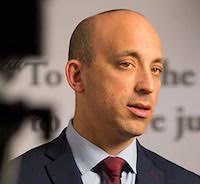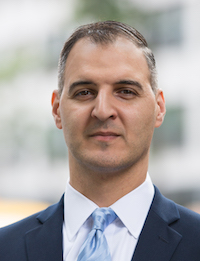Addressing the National Security Threat of White Supremacist Terrorism
In 2018, the Anti-Defamation League (ADL) tracked 50 extremist-related murders, 49 of which were committed by far-right extremists and the majority specifically perpetrated by white supremacists. In the past decade, far-right extremists were responsible for 73 percent of extremist-related murders in the U.S. The Aug. 3 shooting in El Paso took the lives of 22 people, making it the most violent white supremacist attack in 50 years.

Published by The Lawfare Institute
in Cooperation With

In 2018, the Anti-Defamation League (ADL) tracked 50 extremist-related murders, 49 of which were committed by far-right extremists and the majority specifically perpetrated by white supremacists. In the past decade, far-right extremists were responsible for 73 percent of extremist-related murders in the U.S. The Aug. 3 shooting in El Paso took the lives of 22 people, making it the most violent white supremacist attack in 50 years.
White supremacist violence is on the rise—but it is not new. Nearly 25 years ago, Timothy McVeigh used a truck bomb to destroy the Alfred P. Murrah Federal Building in Oklahoma City, murdering 168 people and wounding around 700 others. While McVeigh’s act was inspired by hatred of the federal government, he also took cues from white supremacist literature such as the notorious Turner Diaries, an anti-Semitic and racist screed written by a well-known neo-Nazi. Yet, even after that horrific act, the government failed to develop an integrated response. The country has not since seen an act of domestic terror of this magnitude, but government and civil society need to act now before the death toll climbs even higher.
Not unlike groups such as the Islamic State that are attempting to push back on modernity, white supremacists rage against trends like demographic change and globalization. Their core ideology is predicated on a desire for a white nation and a worldview that sees immigrants, asylum seekers and refugees as enemies who seek to change their culture. Their anger toward outsiders typically is racial in nature, as they rail against “brown” or “black” people, as well as others of different faiths—essentially anyone who does not conform to their idealized notion of white people. They scapegoat those “others” as a way to simplify complex social and economic phenomena. They perceive the Jewish people as their ultimate enemies, responsible for a global conspiracy that includes “open borders,” “multiculturalism” and “globalism” as strategies to engineer “white genocide.”
There is no single cause that motivates individuals to radicalize. Similar to other extremist ideologies espoused by groups like the Islamic State or al-Qaeda, white supremacy results from the interplay of multiple forces. As such, there is no single solution that will solve this problem.
Under normal circumstances, we would call for the federal government to mobilize and lead a whole-of-government or whole-of-nation response. Yet the executive branch, from its leadership on down, refuses to admit that this threat is real. Instead, as we discuss later, it is drawing resources away from, rather than toward, tackling this threat. In this environment, opponents of white supremacist violence must be more creative in bringing the country together to mitigate this growing danger.
Some elements of the threat can be mitigated by traditional government bodies, such as law enforcement agencies. Others necessitate the involvement of nongovernmental actors that are equipped to execute different strategies. This might include the private sector, which has a pivotal role to play—starting with social media platforms that have enabled the spread of extremist networks. Nonprofit organizations can also serve as a crucial, close-to-the-ground resource in helping prevent radicalization and building resilience in communities that may be vulnerable or targeted. Finally, this effort would benefit from cross-sector alliances with these actors working together on certain initiatives. Such public-private partnerships can enable the government to confront this problem from the outside-in.
This problem has been building for some time. But, as the death toll increases, it is time for everyone to step up.
Government
As with any national security crisis—such as responding to the attacks on 9/11 or the threat from the Islamic State—there are some measures that only the government can undertake.
To begin with, Congress should immediately take up a slate of legislation designed to tackle the problem of domestic terrorism. The Domestic Terrorism DATA Act and the Domestic Terrorism Prevention Act would improve the federal government’s work collecting, recording and sharing domestic terrorism data; authorize domestic terrorism offices and units in the Department of Homeland Security, the Department of Justice and the FBI; require federal law enforcement agencies to regularly assess and respond to right-wing extremist threats; provide resources to state and local law enforcement to reduce these threats; and require the federal government to tailor resources expended to the actual threats. In addition, Congress should immediately pass the Khalid Jabara and Heather Heyer National Opposition to Hate, Assault, and Threats to Equality (NO HATE) Act. This legislation would authorize incentive grants to fund improved local and state hate crime training, prevention, best practices, and data collection initiatives—and make grants available for state hate crime reporting hotlines to direct individuals to local law enforcement and support services. The government cannot address what it is not measuring—or not measuring comprehensively.
The federal legal system currently lacks the means to prosecute a white supremacist terrorist as a terrorist. Perpetrators can be prosecuted for weapons charges, acts of violence (including murder), racketeering, hate crimes or other criminal violations. But they cannot be prosecuted for the crime of terrorism. Many experts have argued that there is a danger that would-be domestic terrorists are more likely to be arrested for lesser crimes and subsequently receive lesser sentences.
A criminal domestic terrorism statute would allow federal authorities to charge suspects like the perpetrator in El Paso as a terrorist and disrupt or interdict those attempting or conspiring to carry out similar attacks. But Congress must be clear-eyed in this effort. While there is great utility to naming a threat and ensuring that federal authorities take the threat of domestic terrorism as seriously as they do other forms of terrorism, there is a reason that such a statute has not been created to date. Although the U.S. can designate foreign terrorist organizations to enable a broad range of prosecutable offenses, First Amendment-protected speech and association rights (which do not apply to terrorists operating abroad) rightly preclude designating domestic groups. Moreover, the federal government has a disturbing history of targeting minorities and political activists or political opponents in the name of national security.
It would be unacceptable for Congress to address the threat of white supremacist violence through reforms that overstep or infringe on civil liberties and potentially expand racial profiling or unwarranted, discriminatory surveillance and harassment of marginalized communities. Congress should begin immediate hearings and consultations with legal and policy experts, members of marginalized communities, and law enforcement professionals on whether it is possible to craft a rights-protecting domestic terrorism statute. Any statute Congress would seriously consider should include specific, careful congressional oversight and civil liberties protections to ensure the spirit of such protections are faithfully executed.
State and local authorities have an important role to play as well. The FBI has been tracking hate crimes and preparing an annual report on hate crimes since 1991, but, like all FBI crime reporting, this is voluntary—and it is clearly incomplete. In 2017, the year for which the most current data are available, hundreds of federal and local police agencies did not report any data to the FBI—including nine cities with populations of more than 100,000. Another 82 cities with populations of more than 100,000 reported zero hate crimes to the FBI, a statistic so low as to be unbelievable. Congress should act swiftly to ensure that the federal government transparently reports on hate crimes to the public, and that state and local governments are empowered to effectively report hate crimes to the federal government to guarantee this reporting accurately represents the threat of hate.
Despite all this, without a much larger investment, federal, state and local governments will not make much headway in addressing any of these challenges. Recently, we have seen proposals for $1 billion in investments to counter domestic terrorism. Given that the federal government spends $750 billion per year to fund the Department of Defense, $1 billion to keep communities safe here at home feels like a reasonable start. It will not be easy to find this funding, but it could provide a great return on investment to reduce the trauma the country feels—almost weekly now—amid a never-ending outbreak of mass shootings.
The funding also could be used on research to better understand domestic terrorism. One of us (Selim) ran an office in the Department of Homeland Security providing grants to local communities to counter extremism—but the Trump administration has drastically reduced the office’s funding. The Homeland Security Advisory Council in the previous administration recommended that this office receive $100 million in grants. Congress should provide at least $100 million to these programs.
In light of the current administration’s inadequacies and singular focus on Islamist-motivated forms of extremism, entities outside government must take the lead in preventing extremist violence. A public-private effort—with Congress funding research at universities, technology companies and nonprofit expert organizations, and with state and local government partners—could provide the critical boost that prevention efforts need while also avoiding misgivings many observers have about the implications of an overly federalized effort.
These types of grants can be used to empower community members to provide “off-ramps” from extremism, such as providing counseling and mental health services to individuals seeking to leave extremism behind. Such grants have also been used to help provide noncoercive partnerships between civil society organizations and law enforcement to encourage trust with communities under mutually agreeable terms. And grants can help invest in research to better understand extremist messaging and to figure out ways to undermine those messages that are compliant with freedom of speech, such as by providing “alternative narratives” that might reduce the likelihood that someone would consume extremist content and believe conspiracy theories.
These types of programs can be expanded into relevant areas, such as public health, education and economic development. Other, parallel grant systems could fund public health approaches through the Department of Health and Human Services; economic development in at-risk communities through the Department of Housing and Urban Development or the Commerce Department; and civic education and an understanding of hateful tropes through the Department of Education.
Finally, there are quasi-government actors that also can be engaged as part of an all-hands-on-deck effort. Entities such as In-Q-Tel or the National Science Foundation have the statutory authority to provide funding for targeted innovations that address the public interest. Such agencies can fund projects at academic institutions, make grants to nonprofit organizations or even invest in high-potential startups.
Public-Private Partnerships
At a time when there is little trust between the federal government and affected communities, public-private partnerships can play a uniquely important role. Existing efforts can provide insight about what works—like the National Center for Missing & Exploited Children (NCMEC), a nonprofit organization formed with government funding and direct partnerships with federal agencies. The NCMEC serves as a coordinating body to ensure different entities get the information they need in a timely manner and pursuant to their mission. Sometimes it might be social media platforms; sometimes it could be local law enforcement agencies. But NCMEC always serves as the hub to handle all of these streams of data.
The federal government could create a NCMEC-like agency for domestic terrorism information, such as data, research, or even investigative source information such as dark web or other easily missed pieces of evidence. That way, experts can help share information suitable for tech companies to keep hate and extremism off their platforms, without jeopardizing the civil liberties of their users by criminalizing speech. Similarly, when online content does become incitement to violence or otherwise a crime, this new center could refer it to law enforcement.
Internally, the government already has a similar process for law enforcement and intelligence information related to international terrorism—the National Counterterrorism Center (NCTC). When NCTC was established post-9/11, it served to “[p]roduce integrated and interagency-coordinated analytic assessments on terrorism issues and publishes warnings, alerts, and advisories as appropriate.” The government could expand NCTC’s mandate or create a new center—call it the National Domestic Terrorism Prevention Center—to act as a clearinghouse of digital information; law enforcement information; and, when appropriate based on existing authorities, intelligence. This center could similarly be framed only on the government’s legal authority related to domestic terrorism—including the civil liberties and other limitations on government authorities for pursuing domestic terrorists, but developing a more refined specialization in pursuing such threats—and help ensure information flow throughout the government and significantly deepen government expertise on the issue.
Technology
The private sector also has a critical role to play in addressing this threat. Based on how extremists have—and will continue to—use and abuse technology, tech companies in particular need to be part of the solution. As private entities, tech companies are not subject to the First Amendment, and thus are free to moderate content that the government may not regulate against. At the same time, balancing content moderation with the principles of free speech is incredibly important. If tech companies over-regulate content, this could severely curtail free speech and the speech of marginalized and endangered individuals and groups. Democracies depend on access to knowledge and free speech, and technology companies arguably now provide the largest and most influential forums for both.
Thus, new efforts in this space must not create regulations or other incentives that unnecessarily curtail free speech or innovation or that erect financial barriers that only the largest and wealthiest companies can overcome. However, the engagement of a few platforms could represent a critical mass in tackling this problem. Google, for example, represents 90 percent of all search traffic. Facebook commands more than 2.3 billion users per month. Together, the two companies control almost 60 percent of all digital ads.These two companies must be part of the solution.
One key pillar for private-sector regulation is Section 230 of the Communications Decency Act, which holds that websites and other online services are not liable for third-party content. This 1996 law was written with two purposes: to immunize companies from liability for content that users upload to their sites and, at the same time, to empower those companies to moderate third-party content without fear of liability. While Section 230 has received harsh criticism in recent months, this immunity should be helpful for those who want to see companies combat hate speech: It provides platforms with wide latitude to take action against content that would be lawful under the First Amendment, such as virulent hate speech, disinformation or fake news that can foment violence. Harassing, hateful and dehumanizing speech targeting vulnerable groups can—and, we believe, should—violate the terms of use and community guidelines of private tech companies, even if the same speech would be protected against government prosecution under the First Amendment. And under Section 230, the company need not worry that moderating that type of user-generated content will make the platform liable for defamation or other claims.
Given the widespread misunderstanding of Section 230, it is worth repeating that it is the First Amendment, not Section 230, that protects hateful, offensive and harmful speech from government prosecution. It also bears emphasizing that Section 230 does not provide any shield for violations of federal criminal law, either for those users uploading user-generated content or for platforms that directly or indirectly violate federal criminal law under existing statutes. These two points are constantly misunderstood and misstated, including by lawmakers calling for reform.
That being said, many tech companies have refused to responsibly, transparently and carefully moderate hateful and injurious content. This is changing with respect to the big tech companies such as Google, Facebook and Twitter, although far too slowly and only under threat of more significant government oversight. But other sites—like the social media platform Gab, for example—engage in no moderation at all and provide welcome havens for neo-Nazis and other extremists, including those charged in recent mass shootings.
Regardless of the mechanism, companies must develop and keep updating terms of service that prioritize accountability and reduce their complicity in violent extremism. This hard line-drawing might be done through legislation or through public pressure. Regardless of how a balance is struck, the platforms must mitigate their role in housing 24/7 white supremacist rallies.
Still, tech companies are not alone in responsibility for the hate that propagates online. While laws protect Americans from stalking and harassment offline by holding perpetrators accountable, the law has not caught up when it comes to hate that starts online. Forms of online harassment that until recently did not exist include targeted campaigns that involve sharing personally identifiable information with the intent that it be used for unlawful purposes (doxing), calling swat teams to innocent peoples’ homes (swatting), and the sharing of nonconsensual intimate images. Some litigation has begun to fill this gap, including successful cases against Andrew Anglin, founder and editor of the white supremacist Daily Stormer website. Further, both individuals and organizations alleged to be responsible for the white supremacist torchlight rallies in Charlottesville in 2017 are being sued in federal court in litigation that the ADL is supporting. To better hold perpetrators accountable, federal and state laws must be updated to address crimes that begin online, law enforcement needs increased training, and the general public needs to be better educated about what internet-enabled hate and harassment looks like.
Civil Society
Nonprofits have an important role to play in tackling white supremacist violence. They bring a degree of objectivity that government and businesses simply lack. As was attempted in the case of efforts to interrupt the radicalization of vulnerable populations by groups like the Islamic State and al-Qaeda, we need a whole-of-society effort to intervene to stop white supremacists from recruiting.
As an organization focused on monitoring extremist organizations, the ADL has seen a spike in white supremacist recruiting in recent years—particularly on college campuses where fliering, tabling and explicit recruiting all have jumped. In 2017, we tracked 421 incidents on college campuses, which soared to 1,187 in 2018. This is happening against a backdrop in which public attention on shooters and their manifestos on social media can easily inspire copycats and enable fellow travelers. The Christchurch shooter, for example, invoked the perpetrators of previous massacres in Norway and Charleston. And the shooter in Poway, California, did the same.
One approach that shows considerable promise is the use of “formers.” People who have left extremist movements are uniquely credible to potential adherents to those movements. Organizations such as Life After Hate and prominent rehabilitated figures have an authenticity that resonates with vulnerable populations. Speaking tours, campus visits and media campaigns can elevate their message and mitigate the appeal of extremists. A number of organizations like Ka Joog have done the critical work of youth engagement when international terrorists targeted the Somali American community over the past decade. Other examples abound.
The federal government and communities must find a way to forgive those who truly repent, and to empower law enforcement to reduce sentences for those who commit to help civil society groups that provide such services. If members of hateful groups have an incentive to leave, this might decrease the appeal of joining an extremist group in the first place. The task is to promote community resilience and local resources to prevent individuals from choosing violence through a range of resources and methods, all while measuring what works and consistently growing the “market” of those who promote hope over hate.
Next Steps
Americans across the country are living in fear of the next attack by those who hate them for the color of their skin, their religion, their sexual orientation or gender identity, or their nationality—and many of them do not trust the government to protect them. These ideas alone are not enough to overcome that mistrust or the threat of white supremacist violence. But reforming government, involving the business community, and engaging academia and nonprofit organizations can help address this problem.
It is impossible to completely solve bigotry or the likelihood that it turns violent. Nonetheless, these steps can help us frame an approach that can isolate extremism and keep communities safer.






